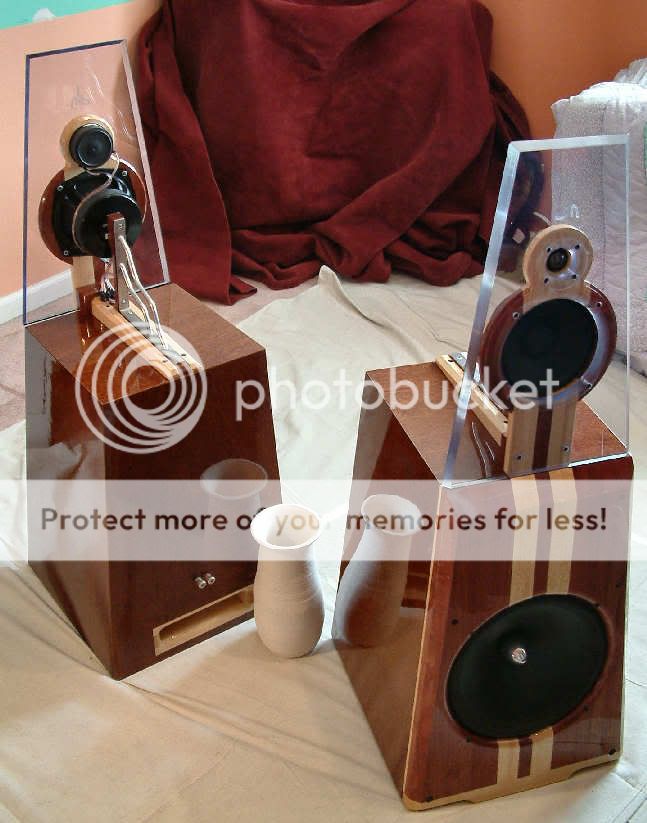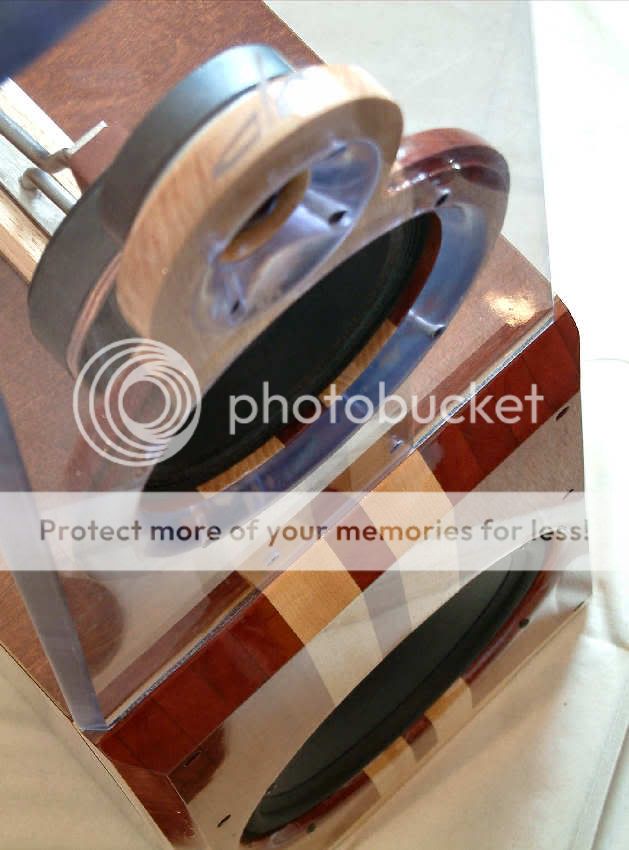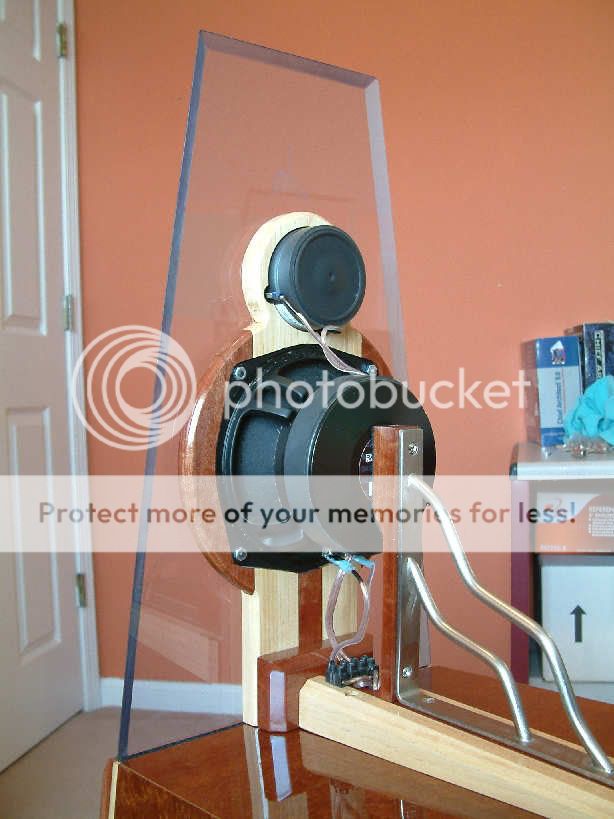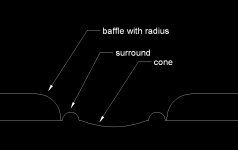I'm wondering how the sound will be affected by mounting driver on the inside of a baffle with a radiused corner? I imagine it will get a slight waveguide effect but how much? Would there be enough change to have to redesign a existing crossover? Just speculating here.
Attachments
I wonder if there is a noticeable difference between a chamfer and a radius?
Dunno but the chamfer removes more obstacle. I did a chamfer on my last take on rear-mounting, and it did need some additional smoothing of the edges to not interfere with imaging (at least, not as much as it was before I softened the edges of the chamfer by sanding).
This was with a highly directional driver (8" JBL LE8T) for the frequencies of concern, so it's pretty important for anything playing high.
On a small midrange backmounted ought to have good effect on giving it more space to breathe
And it makes phase allignment with woofer better, if that one is frontmounted
A tweeter should benefit as well
Much smoother surface, no screw edges and such
In the 3way I am building now, I will mount mid and tweet on the back of their own small removeable baffle
I might use 12mm plywood, but I guess 6-8mm alu plate would be fine too
Maybe I will consider double 12mm around tweeter, and make it into a small waveguide
And it makes phase allignment with woofer better, if that one is frontmounted
A tweeter should benefit as well
Much smoother surface, no screw edges and such
In the 3way I am building now, I will mount mid and tweet on the back of their own small removeable baffle
I might use 12mm plywood, but I guess 6-8mm alu plate would be fine too
Maybe I will consider double 12mm around tweeter, and make it into a small waveguide
I'm wondering how the sound will be affected by mounting driver on the inside of a baffle with a radiused corner? I imagine it will get a slight waveguide effect but how much? Would there be enough change to have to redesign a existing crossover? Just speculating here.
I am going to redo my designs using the exact same approach - with a radius. There won't be much of a waveguide effect and with the radius there won't be much diffraction difference either. BUT, the driver is moving back - 3/4" in my case - and there will be a phase change in the far field, so I am anticipating a small crossover change to the woofer to compensate for this.
There will be a slight added acoustic mass at resonance, but for a closed box this is pretty benign. Ported, maybe not so.
Thanks for the replies. Some of the thoughts I get:
Rear mounting a full range driver should help the highs by a small amount (maybe beneficial depending on the driver)
Multiway could require some crossover changes, but it would seem best to measure and compare to get the final word on how much effect it would have.
Rear mounting a full range driver should help the highs by a small amount (maybe beneficial depending on the driver)
Multiway could require some crossover changes, but it would seem best to measure and compare to get the final word on how much effect it would have.
I am going to redo my designs using the exact same approach - with a radius. There won't be much of a waveguide effect and with the radius there won't be much diffraction difference either. BUT, the driver is moving back - 3/4" in my case - and there will be a phase change in the far field, so I am anticipating a small crossover change to the woofer to compensate for this.
There will be a slight added acoustic mass at resonance, but for a closed box this is pretty benign. Ported, maybe not so.
An over-radius chamfering/rounding will have the best effect. By trial and error I've found a roughly 20% over-radius to yield the best result to limit diffraction effects.
However, the largest benefit of back-mounting a woofer is that you can have a "floating" outer cabinet that isn't mechanically coupled to the "inner" cabinet at any point, and thereby reducing vibrations in the front baffle and cabinet in general dramatically.
By trial and error I've found a roughly 20% over-radius to yield the best result to limit diffraction effects.
Whats an "over-radius"? and what do you judge "best" by.
Whats an "over-radius"? and what do you judge "best" by.
It's using a rounding radius larger than the board thickness. Eg., using a 21mm radius rounding tool to round a 18mm baffle. That way the rounding starts out like chamfer closest to the driver,
And by "best" I mean the least diffraction, and less than flush mounting the driver on the front.
is there a simple(ish) way to calculate this?
intriguing thread...i have considered rear mounting the dome tweeter on my latest project but havent due to a concern that it may give to much HF gain for my liking, alhtough the benifit of reducing the driver displacements is obvious...
as my tweeter is about 95 mm round i was considering chamfering the cut out...say 75mm diameter in 19 mm MDF, and like someone just said, chamfering with oversize bit (like 21mm)
is there any way to model or predict the possible behavior, other than to suck it and see so to speak?
intriguing thread...i have considered rear mounting the dome tweeter on my latest project but havent due to a concern that it may give to much HF gain for my liking, alhtough the benifit of reducing the driver displacements is obvious...
as my tweeter is about 95 mm round i was considering chamfering the cut out...say 75mm diameter in 19 mm MDF, and like someone just said, chamfering with oversize bit (like 21mm)
is there any way to model or predict the possible behavior, other than to suck it and see so to speak?
And by "best" I mean the least diffraction ...
And how was that determined?
Check out this thread. In particular, post #9 shows a comparison graph of the Peerless HDS tweeter flush mounted at 0-15-30-45-60º off axis and one that is mounted in a shallow wavegide that has a 1-5/16" throat dia., is 3/4" deep and has a 3/4" roundover:
http://www.diyaudio.com/forums/multi-way/132587-how-construct-elliptical-waveguide-tweeter.html
The waveguide results are pasted exactly 15db above the flush mount results. To compare them, look at the results of the flush mounted HDS at any given point in frequency and on any given axis location and add 15db (each line is 5db) and you can see how much boost the shallow waveguide provides. You can also see the direcivity changes the shallow waveguide provides. Also, in post 2, there is a link to experiments I posted over at HTGuide that used shallower waveguides, different roundovers and also some chamfers. The important thing to note, is that you can't simply mount the tweeter from behind and predict the results. I believe you really need to have measurement gear to be able to effectively use a rear mounted driver.
In addition, I mounted the woofer and midrange (open baffle dipole) in the design these wee done for from the rear, with 3/4" roundovers. On the woofer the rear mount made little difference in its passband (XO at 450z). In the open baffle midrange, however, the response was smoother in beneral than the flush mount measurement. Also, the flush mount had an off axis peaking above the dipole dip that was much more substantial than with the rear mount. Below is the speakers these were employed in:



http://www.diyaudio.com/forums/multi-way/132587-how-construct-elliptical-waveguide-tweeter.html
The waveguide results are pasted exactly 15db above the flush mount results. To compare them, look at the results of the flush mounted HDS at any given point in frequency and on any given axis location and add 15db (each line is 5db) and you can see how much boost the shallow waveguide provides. You can also see the direcivity changes the shallow waveguide provides. Also, in post 2, there is a link to experiments I posted over at HTGuide that used shallower waveguides, different roundovers and also some chamfers. The important thing to note, is that you can't simply mount the tweeter from behind and predict the results. I believe you really need to have measurement gear to be able to effectively use a rear mounted driver.
In addition, I mounted the woofer and midrange (open baffle dipole) in the design these wee done for from the rear, with 3/4" roundovers. On the woofer the rear mount made little difference in its passband (XO at 450z). In the open baffle midrange, however, the response was smoother in beneral than the flush mount measurement. Also, the flush mount had an off axis peaking above the dipole dip that was much more substantial than with the rear mount. Below is the speakers these were employed in:



right so then am i right in thinking that a 70mm 'throat' would cause a less pronounced horn effect as it would act at a lower frequency?
Considering im using a visaton gc20mm dome im guessing that reflection or diffraction would be more significant in my desired set up(70mm cutout chamfered at either 19mm, or over 21mm)
looking at it that way i think it may worsen diffraction and not be better than flush mounting, in my case and thus possibly not worth the gains in phase alignment that i am seeking.
Very interesting though.
Considering im using a visaton gc20mm dome im guessing that reflection or diffraction would be more significant in my desired set up(70mm cutout chamfered at either 19mm, or over 21mm)
looking at it that way i think it may worsen diffraction and not be better than flush mounting, in my case and thus possibly not worth the gains in phase alignment that i am seeking.
Very interesting though.
And how was that determined?
As noted by dlneubec above.
In general a smoother response at higher frequencies is observed especially at off-axis angles.
Please note that I'm referring to backmounting woofers and midrange drivers here.
As noted by dlneubec above.
I see. In general measuring the diffraction field, or the effects of diffraction can be very difficult. There are many things that can cause similar effects and it is not at all obviuos which are diffraction and which aren't.
I have been talking about diffraction alot and now its gotten to be a kind of "buzz word". The problem is that a lot of the talk about diffraction isn't correct.
In many ways diffraction is always present. That's because the sound radiation from a piston - for example - can be shown to be equivalent to two completely different situations, one where the diffraction is explicit and one where it isn't. Now does that mean that the rigid piston does or does not have diffraction? Because in one case I can prove that its there and in the other its not. The whole discussion is ripe for this kind of ambiguity.
In the case of a waveguide there is a form of wave propagation -HOM - that can only come about as the result of diffraction IF the source is a plane wave. In this case it is quite clear what is and is not diffraction. But in the real world it becomes quite ambigous when the source may not be a plane wave since some of the HOM may be from diffraction and some from the source. The general case of diffraction is virtually always ambiguous and it is not at all clear what is what.
Hence it would be very difficult for you to prove that the changes seen in the curves shown by dlnuebec are the result of diffraction or not because this is clearly in the ambiguous range of situations that I described above for the rigid piston.
- Status
- This old topic is closed. If you want to reopen this topic, contact a moderator using the "Report Post" button.
- Home
- Loudspeakers
- Multi-Way
- Effect of mounting driver on the inside of a baffle?
